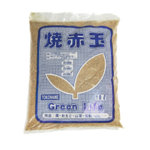Do ask
@markyscott .
This conversation is some quasihybrid commercial/geoillogical discussion of a nerdy soil war!
See just this
Page. We first must define Calcine Before we can talk about it's effects.
The Earth made Akadama. If it's treated with heat for customs it's probably taken to much lower temperatures, which won't change the chemical composition.
Not only can these grades of Akadama have been made in one eruption, but if we consider millions of years of eruptions, differing sea levels which will change salt content and cooling rates, we can start to see how the Japanese are probably avoiding 98 deposits of Akadama, to bag the 3 grades that work.
Calcined, the human process as I know it for glazes, Takes the chemical water out of the clay. I've read 12 and 14% of total weight is chemical water. One must be wrong? Or it could be a different Clay.
Funny story....
We went to Andy's, that Ice Cream Place that's not as good as the one in the old neighborhood.....anyway...
They had a sign on the thing said Now Hiring $10.
I was like, "what's an SIO!?" Lol, she said "it says ten dollars dumbass!", Me without my glasses!
So when I realized silica is SiO2, it was a sign I was on the right path. I tell her I'm an SIO now!
Yeah, I love this game!
Sorce






